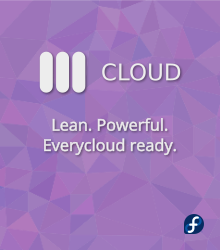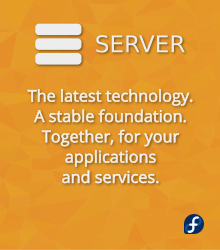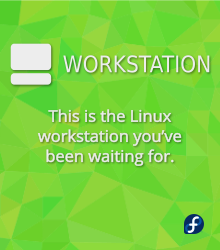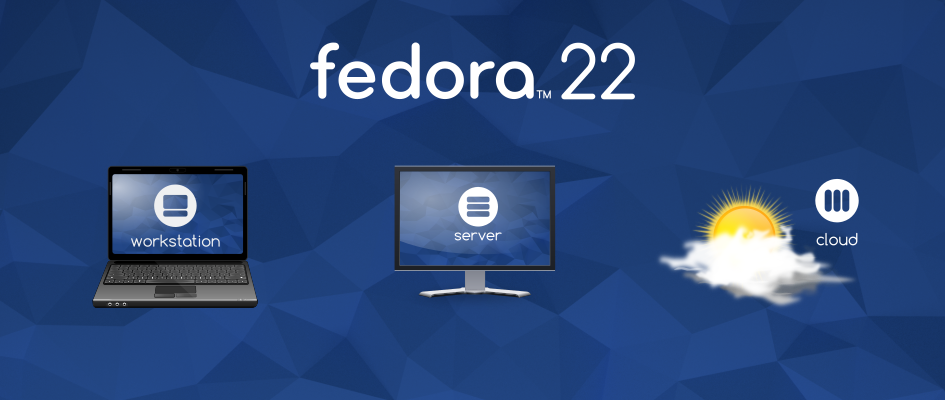m (internal link cleaning) |
|||
| (18 intermediate revisions by one other user not shown) | |||
| Line 1: | Line 1: | ||
{{ | {{admon/note||If you'd like to read this page in Glorious Technicolor (not really, but there are more graphics), visit the [http://fedoramagazine.org/fedora-22-released/ Fedora 22 Announcement on Fedora Magazine].}} | ||
' | |||
| Line 9: | Line 7: | ||
We are proud to announce the official release of Fedora 22, the community-driven and community-built operating system now available in Cloud, Server, and Workstation editions. | We are proud to announce the official release of Fedora 22, the community-driven and community-built operating system now available in Cloud, Server, and Workstation editions. | ||
If that's all you need to hear, jump over to https://getfedora.org/ to download — or for current users, run the [ | If that's all you need to hear, jump over to https://getfedora.org/ to download — or for current users, run the [[FedUp|upgrade tool]]. | ||
In addition to the latest versions of all your favorite free and open source software, Fedora 22 marks our second release with distinctly-targeted offerings for cloud computing, the server room, and the desktops and laptops of software developers and creators everywhere. Thanks to the hard work of developers, designers, packagers, translators, testers, documentation writers, and everyone else, we're incredibly confident in saying that this is our best and most polished release yet. | In addition to the latest versions of all your favorite free and open source software, Fedora 22 marks our second release with distinctly-targeted offerings for cloud computing, the server room, and the desktops and laptops of software developers and creators everywhere. Thanks to the hard work of developers, designers, packagers, translators, testers, documentation writers, and everyone else, we're incredibly confident in saying that this is our best and most polished release yet. | ||
Also with this release, we return to our traditional six-month cadence — we'll see you back here sometime around Halloween! | |||
= Highlights in the Fedora 22 release = | = Highlights in the Fedora 22 release = | ||
| Line 25: | Line 23: | ||
Fedora 22 Cloud edition has a number of interesting updates that should be exciting for users and developers. | Fedora 22 Cloud edition has a number of interesting updates that should be exciting for users and developers. | ||
* '''Updated Docker Images''' – The Fedora 22 release includes updated Docker images that you can use as the base of your containerized applications. | * '''[https://getfedora.org/en/cloud/download/docker.html Updated Docker Images]''' – The Fedora 22 release includes updated Docker images that you can use as the base of your containerized applications. | ||
* '''Vagrant Boxes''' – One of the oft-requested features for Fedora is an "official" Vagrant box that developers can use to spin up images using the popular [https://www.vagrantup.com/ Vagrant] tool for building development environments. With the Fedora 22 release we now offer Vagrant Boxes for libvirt and VirtualBox, so developers on Linux, Mac OS X, and Windows can spin up Fedora-based development environments with ease. Users can choose a Vagrant box for Fedora 22 Atomic Host and Fedora 22 Cloud base edition. | * '''[https://getfedora.org/en/cloud/download/index.html#vagrant Vagrant Boxes]''' – One of the oft-requested features for Fedora is an "official" Vagrant box that developers can use to spin up images using the popular [https://www.vagrantup.com/ Vagrant] tool for building development environments. With the Fedora 22 release we now offer Vagrant Boxes for libvirt and VirtualBox, so developers on Linux, Mac OS X, and Windows can spin up Fedora-based development environments with ease. Users can choose a Vagrant box for Fedora 22 Atomic Host and Fedora 22 Cloud base edition. | ||
* '''Atomic Improvements''' – Fedora 22 Atomic Host includes a number of interesting improvements, including the '''Atomic''' command, updated Docker, Kubernetes, Flannel, and rpm-ostree packages. | * '''Atomic Improvements''' – Fedora 22 Atomic Host includes a number of interesting improvements, including the '''Atomic''' command, updated Docker, Kubernetes, Flannel, and rpm-ostree packages. | ||
* '''Dockerfiles''' – Fedora 22 also includes a fedora-dockerfiles package (and up-to-date git repository) for building applications with the base Fedora 22 Dockerfile and additional packages. | * '''Dockerfiles''' – Fedora 22 also includes a [https://apps.fedoraproject.org/packages/fedora-dockerfiles fedora-dockerfiles package] (and up-to-date git repository) for building applications with the base Fedora 22 Dockerfile and additional packages. | ||
== Fedora Server == | == Fedora Server == | ||
[[File:Fedora-server-v5a-infinity.png|right]] | [[File:Fedora-server-v5a-infinity.png|right]] | ||
* [[Changes/DatabaseServerRole | '''Database Server Role.''']] The Fedora Server | * [[Changes/DatabaseServerRole | '''Database Server Role.''']] The Fedora Server edition focuses on easy of different server roles. Fedora 21 debuted with an Domain Controller Role featuring FreeIPA. For this release, we've added a Database Server role, built around PostgreSQL. | ||
* '''Default to [[Server/Technical_Specification#File_system | XFS filesystem.]]''' The default file system type for Fedora Server installs will be XFS running atop LVM for all partitions except /boot. The /boot partition will remain a non-LVM, ext4 partition due to technological limitations of the bootloader. | * '''Default to [[Server/Technical_Specification#File_system | XFS filesystem.]]''' The default file system type for Fedora Server installs will be XFS running atop LVM for all partitions except /boot. The /boot partition will remain a non-LVM, ext4 partition due to technological limitations of the bootloader. | ||
* '''[[Changes/CockpitManagementConsole | Cockpit]] will be compatible between OS releases.''' Cockpit is a server manager that makes it easy to administer your GNU/Linux servers via a web browser. | * '''[[Changes/CockpitManagementConsole | Cockpit]] will be compatible between OS releases.''' Cockpit is a server manager that makes it easy to administer your GNU/Linux servers via a web browser. | ||
| Line 55: | Line 51: | ||
** '''Vagrant.''' Developers will appreciate the addition of software development environment software Vagrant into Fedora — it'll work using our included virtualization technology, with no need to install third-party virtualization (like VirtualBox). Use this to work on top of the Cloud images mentioned above, or launch your own Vagrant boxes. | ** '''Vagrant.''' Developers will appreciate the addition of software development environment software Vagrant into Fedora — it'll work using our included virtualization technology, with no need to install third-party virtualization (like VirtualBox). Use this to work on top of the Cloud images mentioned above, or launch your own Vagrant boxes. | ||
== Spins == | == Spins, Labs, and ARM == | ||
Spins are alternative desktop environments for Fedora, including KDE, Xfce, LXDE, MATE-Compiz, and SOAS (Sugar on a Stick). We have a new website presenting these at https://spins.fedoraproject.org/. Of particular note for F22: | |||
=== Fedora 22 KDE Plasma === | |||
Plasma 5, the successor to KDE Plasma 4, is now the default workspace in the Fedora KDE spin. It has a new theme called Breeze, which has cleaner visuals and better readability, improves certain work-flows and provides overall more consistent and polished interface. Changes under the hood include switch to Qt 5 and KDE Frameworks 5 and migration to a fully hardware-accelerated graphics stack based on OpenGL(ES). | Plasma 5, the successor to KDE Plasma 4, is now the default workspace in the Fedora KDE spin. It has a new theme called Breeze, which has cleaner visuals and better readability, improves certain work-flows and provides overall more consistent and polished interface. Changes under the hood include switch to Qt 5 and KDE Frameworks 5 and migration to a fully hardware-accelerated graphics stack based on OpenGL(ES). | ||
=== Fedora 22 Xfce === | |||
The Xfce spin has been updated to Xfce 4.12. This release has an enormous number of improvements, including HiDPI support, improvements to window tiling, support for Gtk3 plugins, and many improvements for multi-monitor support. | The Xfce spin has been updated to Xfce 4.12. This release has an enormous number of improvements, including HiDPI support, improvements to window tiling, support for Gtk3 plugins, and many improvements for multi-monitor support. | ||
=== Labs === | |||
We also have a new site, presenting functional bundles of software which were previously also collected as Spins. Visit https://labs.fedoraproject.org/ for collections focusing on gaming, audio production, robotics, security, and more. | |||
=== ARM Architecture === | |||
Previously, images for the ARM architecture were mixed into the Spins page. They now have their own home at https://arm.fedoraproject.org/, with downloads for Fedora Server, Fedora Workstation, and for several Spins as well. Note that this currently covers 32-bit ARM; Aarch64 will be released as a secondary architecture later today. | |||
== Other changes of note == | == Other changes of note == | ||
| Line 73: | Line 79: | ||
It also boasts a better performance and memory footprint vs. Yum, and is designed to have a cleaner codebase and be easier to maintain. | It also boasts a better performance and memory footprint vs. Yum, and is designed to have a cleaner codebase and be easier to maintain. | ||
If you're using the Fedora 22 Workstation edition, and managing packages with the '''Software''' Application, odds are you won't notice a difference. Server and | If you're using the Fedora 22 Workstation edition, and managing packages with the '''Software''' Application, odds are you won't notice a difference. Server and Cloud users who fall back on '''Yum''' commands will receive a reminder (courtesy of dnf-yum) that Yum is deprecated and DNF is now the default package manager. DNF has been in development for quite some time, so we're confident it's ready for prime time. The classic Yum command line tool has been renamed to yum-deprecated as a transitional step for tools still using it. [http://dnf.readthedocs.org/en/latest/cli_vs_yum.html See Read The Docs for compatibility changes from Yum to DNF in detail]. | ||
=== Elasticsearch === | === Elasticsearch === | ||
Elasticsearch is | Elasticsearch is full-featured and very popular self-standing open source indexing server, and now it's available by with just a "<tt>yum install elasticsearch</tt>" — no, wait, make that "<tt>dnf install elasticsearch</tt>"! | ||
=== GNU Compiler Collection 5 === | === GNU Compiler Collection 5 === | ||
| Line 88: | Line 94: | ||
You can start by downloading Fedora 22: | You can start by downloading Fedora 22: | ||
: | : https://getfedora.org/ | ||
If you are upgrading from a previous release of Fedora, refer to: | If you are upgrading from a previous release of Fedora, refer to: | ||
| Line 108: | Line 114: | ||
: http://fedoraproject.org/wiki/Common_F22_bugs | : http://fedoraproject.org/wiki/Common_F22_bugs | ||
This page includes information on several known non-blocker bugs in Fedora 22 | This page includes information on several known non-blocker bugs in Fedora 22. Please be sure to read it before installing! | ||
[[File:F22-editions.png|center]] | [[File:F22-editions.png|center]] | ||
Latest revision as of 13:58, 18 September 2016
Announcing Fedora 22
We are proud to announce the official release of Fedora 22, the community-driven and community-built operating system now available in Cloud, Server, and Workstation editions.
If that's all you need to hear, jump over to https://getfedora.org/ to download — or for current users, run the upgrade tool.
In addition to the latest versions of all your favorite free and open source software, Fedora 22 marks our second release with distinctly-targeted offerings for cloud computing, the server room, and the desktops and laptops of software developers and creators everywhere. Thanks to the hard work of developers, designers, packagers, translators, testers, documentation writers, and everyone else, we're incredibly confident in saying that this is our best and most polished release yet.
Also with this release, we return to our traditional six-month cadence — we'll see you back here sometime around Halloween!
Highlights in the Fedora 22 release
Every Fedora release has its own character. If this release had a human analogue, it'd be Fedora 21 after it'd been to college, landed a good job, and kept its New Year's Resolution to go to the gym on a regular basis. What we're saying is that Fedora 22 has built on the foundation we laid with Fedora 21 and the work to create distinct editions of Fedora focused on the desktop, server, and cloud (respectively). It's not radically different, but there are a fair amount of new features coupled with features we've already introduced but have improved for Fedora 22.
Fedora Cloud

Fedora 22 Cloud edition has a number of interesting updates that should be exciting for users and developers.
- Updated Docker Images – The Fedora 22 release includes updated Docker images that you can use as the base of your containerized applications.
- Vagrant Boxes – One of the oft-requested features for Fedora is an "official" Vagrant box that developers can use to spin up images using the popular Vagrant tool for building development environments. With the Fedora 22 release we now offer Vagrant Boxes for libvirt and VirtualBox, so developers on Linux, Mac OS X, and Windows can spin up Fedora-based development environments with ease. Users can choose a Vagrant box for Fedora 22 Atomic Host and Fedora 22 Cloud base edition.
- Atomic Improvements – Fedora 22 Atomic Host includes a number of interesting improvements, including the Atomic command, updated Docker, Kubernetes, Flannel, and rpm-ostree packages.
- Dockerfiles – Fedora 22 also includes a fedora-dockerfiles package (and up-to-date git repository) for building applications with the base Fedora 22 Dockerfile and additional packages.
Fedora Server

- Database Server Role. The Fedora Server edition focuses on easy of different server roles. Fedora 21 debuted with an Domain Controller Role featuring FreeIPA. For this release, we've added a Database Server role, built around PostgreSQL.
- Default to XFS filesystem. The default file system type for Fedora Server installs will be XFS running atop LVM for all partitions except /boot. The /boot partition will remain a non-LVM, ext4 partition due to technological limitations of the bootloader.
- Cockpit will be compatible between OS releases. Cockpit is a server manager that makes it easy to administer your GNU/Linux servers via a web browser.
- Easy to use. Cockpit is perfect for new sysadmins, allowing them to easily perform simple tasks such as storage administration, inspecting journals and starting and stopping services.
- No interference. Jumping between the terminal and the web tool is no problem. A service started via Cockpit can be stopped via the terminal. Likewise, if an error occurs in the terminal, it can be seen in the Cockpit journal interface.
- Multi-server. You can monitor and administer several servers at the same time.
Fedora Workstation

- Better notifications. Thanks both to work done in GNOME 3.16 and other projects like the Automatic Bug Reporting Tool (ABRT), notifications keep you better informed, but interfere less with your work. They now appear anchored to the center of the top bar, and no longer cover up the bottom of the screen where you are often reading a terminal or browser. An unobtrusive marker appears in the calendar to let you know you have unread notifications. If ABRT detects a serious bug, a friendly notification appears and allows you to report the bug information, but doesn't overload you with details. And if you're a serious Terminal user, longer background jobs now notify you when they're done, so you can get on with other work and pick up the results when you're ready.
- Refined themes. The GNOME Shell and other themes and design are refined and improved. Now you can more easily identify information on the screen, adjust window size and placement, and navigate your files and folders. Improved bridging between desktop environment themes allows apps from other environments like KDE to look and feel more like native apps as they're updated to take advantage of this feature. Standard scrollbars have been replaced by a minimal, overlaid indicator, while a scrollbar trough is shown when needed. This create a cleaner, less distracting view which helps you focus on window content. These "overlay scrollbars" are also better suited to mouse scroll wheels and touchpad scrolling.
- Application improvements
- Software. The Software app has more and better data than ever before, and makes it easy for you to find a wide variety of useful free software. It also makes keeping your system up to date a snap. The Software app also can install all sorts of extras such as fonts or media helpers.
- Files. The updated layout in Files gives a better view of your files and folders, and a new view popover makes it easy to change the zoom level and sort order from a single place. You can also now move files and folders to the trash intuitively using the Delete key, rather than the Ctrl+Delete keyboard combination.
- Image Viewer.. The Image Viewer has been redesigned to reduce the amount of window chrome and give more space to images.
- Boxes. The user interface for Boxes, the application for virtual and remote machines, has a large number of improvements, including new preferences dialogs, a revamped box creation assistant, a feature to send keyboard shortcuts to a box, and display scaling by default.
- Vagrant. Developers will appreciate the addition of software development environment software Vagrant into Fedora — it'll work using our included virtualization technology, with no need to install third-party virtualization (like VirtualBox). Use this to work on top of the Cloud images mentioned above, or launch your own Vagrant boxes.
Spins, Labs, and ARM
Spins are alternative desktop environments for Fedora, including KDE, Xfce, LXDE, MATE-Compiz, and SOAS (Sugar on a Stick). We have a new website presenting these at https://spins.fedoraproject.org/. Of particular note for F22:
Fedora 22 KDE Plasma
Plasma 5, the successor to KDE Plasma 4, is now the default workspace in the Fedora KDE spin. It has a new theme called Breeze, which has cleaner visuals and better readability, improves certain work-flows and provides overall more consistent and polished interface. Changes under the hood include switch to Qt 5 and KDE Frameworks 5 and migration to a fully hardware-accelerated graphics stack based on OpenGL(ES).
Fedora 22 Xfce
The Xfce spin has been updated to Xfce 4.12. This release has an enormous number of improvements, including HiDPI support, improvements to window tiling, support for Gtk3 plugins, and many improvements for multi-monitor support.
Labs
We also have a new site, presenting functional bundles of software which were previously also collected as Spins. Visit https://labs.fedoraproject.org/ for collections focusing on gaming, audio production, robotics, security, and more.
ARM Architecture
Previously, images for the ARM architecture were mixed into the Spins page. They now have their own home at https://arm.fedoraproject.org/, with downloads for Fedora Server, Fedora Workstation, and for several Spins as well. Note that this currently covers 32-bit ARM; Aarch64 will be released as a secondary architecture later today.
Other changes of note
Faster and better dependency management with DNF
With Fedora 22, we're introducing a major change under the hood. Specifically, we're now using DNF and hawkey to manage packages. DNF is much like the Yum software package manager (it's largely command-line compatible), but re-written and re-engineered to provide optimal performance and (along with Hawkey) provide a strict API definition for plugins and extending projects. DNF also makes use of the libsolv library initially pioneered by the openSUSE Project to provide faster and better dependency management.
It also boasts a better performance and memory footprint vs. Yum, and is designed to have a cleaner codebase and be easier to maintain.
If you're using the Fedora 22 Workstation edition, and managing packages with the Software Application, odds are you won't notice a difference. Server and Cloud users who fall back on Yum commands will receive a reminder (courtesy of dnf-yum) that Yum is deprecated and DNF is now the default package manager. DNF has been in development for quite some time, so we're confident it's ready for prime time. The classic Yum command line tool has been renamed to yum-deprecated as a transitional step for tools still using it. See Read The Docs for compatibility changes from Yum to DNF in detail.
Elasticsearch
Elasticsearch is full-featured and very popular self-standing open source indexing server, and now it's available by with just a "yum install elasticsearch" — no, wait, make that "dnf install elasticsearch"!
GNU Compiler Collection 5
Fedora 22 comes with GCC 5.1 as the primary compiler suite.
Downloads, upgrades, documentation, and common bugs
You can start by downloading Fedora 22:
If you are upgrading from a previous release of Fedora, refer to:
Fedora's FedUp utility enables an easy upgrade to Fedora 22 from previous releases. See the FedUp page on the Fedora wiki for more information:
Documentation
Read the full release notes for Fedora 22, guides for several languages, and learn about known bugs and how to report new ones:
Fedora 22 common bugs are documented at:
This page includes information on several known non-blocker bugs in Fedora 22. Please be sure to read it before installing!

